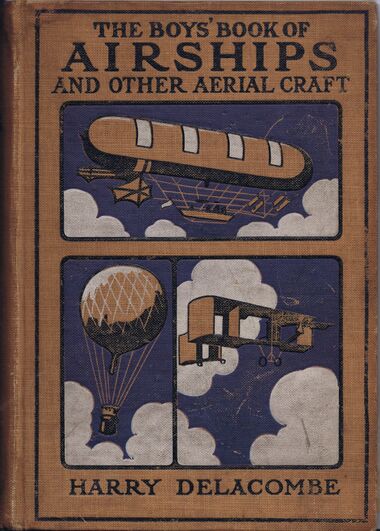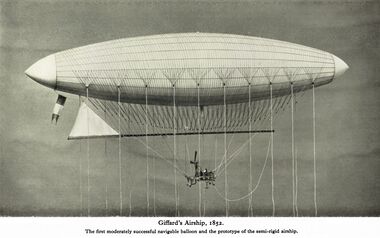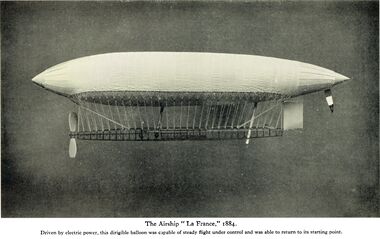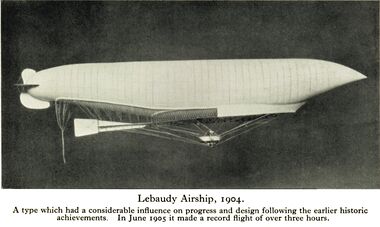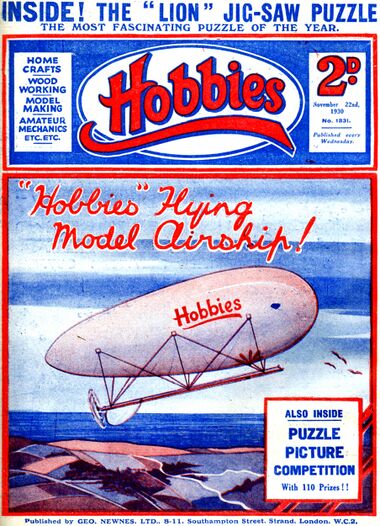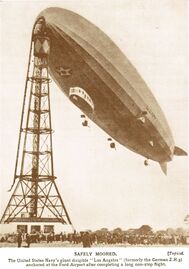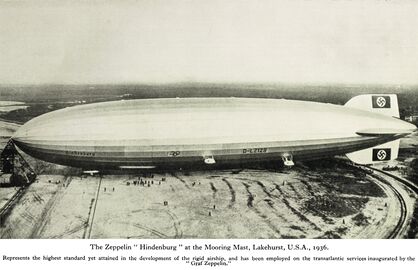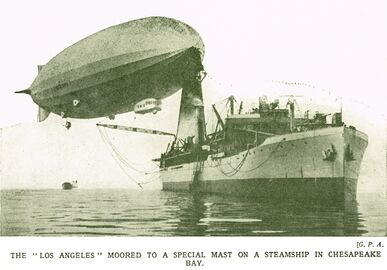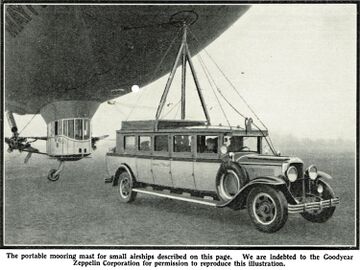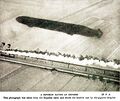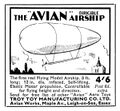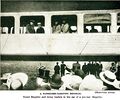Category:Airships
The Boys' Book of Airships [image info]
1852: Giffard's Airship [image info]
1884: LaFrance Airship [image info]
1904: Lebaudy Airship [image info]
1930: Hobbies model airship design [image info]
1928 discussion:
THE ROMANCE OF BIG AIRSHIPS
...
Practically speaking, serious attempts to build a balloon whose direction of flight could be controlled (hence the term "dirigible", from the French diriger—to direct) began in the latter half of the nineteenth century.
Many years before, in 1784, the French General Meusnier proposed an elongated balloon that should be driven by man-propelled oars, and two brothers named Robert actually attained in this way a speed relative to the wind of about three miles an hour. But it was so obvious that a much more powerful engine was required. to make progress against even gentle breezes that experiments were discontinued until 1852, when Henri Giffard ascended with a steam engine of then unprecedented lightness. From that date onwards to the end of the century several dirigible balloons were built, some with steam engines, others with electric motors. La France, an electrically-propelled balloon designed by two French officers, Renard and Krebs, reached a speed of fourteen miles an hour.
It was the invention of the internal combustion engine (to which type belongs the engine of the modern motor-car) that made flight by airship, and ultimately by aeroplane, practicable. After years of experiment, Dr. Wolfërt built in Berlin a cigar-shaped balloon driven by a gasoline engine of this type. Unfortunately it exploded in midair, and both the doctor and his assistant were killed.
Until this time all airships had consisted simply of a flexible envelope holding hydrogen or coal gas, from which was suspended a small car containing engine, crew, and the driving air-screw. They belonged to the class called "non-rigid."
In 1897 a dirigible that may be called the first rigid airship was built. It was an aluminium balloon, designed by D. Schwarz, driven by a benzine engine. It proved on its first flight over Berlin to be faster than La France, but was damaged beyond repair on landing.
Schwarz, however, had pointed the way to a new solution of the problem of airship flight. The rigid airship has a number of separate gas-bags, or "ballonets," contained in a rigid lattice framework of steel, wood, or aluminium alloy. To this class belong R 100 and R 101, the new great British airships, and, though big claims are made for the semi-rigid type (which has a rigid keel to carry the weight of cabins and engine-cars and to take all strains, the whole being slung beneath a flexible gas-container), it seems that the rigid system of construction is best in all but very small airships.
First to tread the path indicated by Schwarz was a man whose name is known all over the world, Count Ferdinand von Zeppelin. His life history and the determination with which he fought every setback make him—in spite of the uses to which his airships were put during the War – a picturesque figure in the history of aviation.
He was 53, an age at which many men begin to think of retiring to slippered ease and rest, when, in 1891, he left the German Army to begin a new career devoted to the study of aeronautics. His work cost him his entire fortune. Again and again disaster overtook his latest vessel and forced him to begin afresh. His Kaiser, Wilhelm II, declared brutally that his was "an impracticable dream."
But the old soldier, who was first to cross the French frontier in the war of 1870 and had fought as a volunteer in the American Civil War, refused to be beaten. In all, he made three fresh starts, and lived to see most of his dreams realized, though the Great War ruined his favourite project—the establishment of world airship services radiating from Berlin.
He began to build the first "Zeppelin" airship in 1897. It consisted of an aluminium framework containing sixteen gas-bags. The first flight, made in 1900, ended disastrously, the vessel crashing on landing after flying about 31 miles. His second airship, slightly smaller but more powerful, was wrecked in a gale in 1905, after making several successful ascents. The third, of much improved design, attained a speed of thirty-six miles an hour with eleven passengers on board and remained in the air for several hours. Next year, 1908, a fourth Zeppelin, after flying 250 miles in eleven hours, was wrecked on land in a storm and burnt. But its success had seized the imagination of the German people and – Zeppelin's own fortune being exhausted – subscriptions, headed by the once incredulous Kaiser, were at once raised to enable him to build another airship.
Britain's first "rigid" was begun in 1909. During previous years British designers – in particular the late Captain E. T. Willows – had attained considerable success in the building of non-rigid craft, but Zeppelin's progress turned all thoughts to the rigid system. Like the early Zeppelins, our first airships, fragile, cumbersome craft, had unlucky ends. The first British ship broke amidships in 1911, the result of a mistake in handling her on getting her out of the airship shed.
Other British ships followed, each better than the last. Some of them did notable things, but the first great step towards a real dirigible air liner was made possible in September, 1916, during the War, when the German military vessel L 33 was brought down so comparatively undamaged that it was possible, from close examination of her structure, to prepare plans for two famous British ships – R 33 and R 34. The German ship herself marked a new stage in rigid airship design, having been built by the combined brains of the Zeppelin Company and the Schütte-Lanz firm, whose wooden airships first embodied some of the most important constructional features of modern rigid practice.
After the War R 33 and R 34 made history. The R 34, commanded by Major G. H. Scott, accomplished, in 1919, the first return flight across the Atlantic to the United States. Then the ZR 3 – now the United States airship Los Angeles – piloted by Dr. Eckener, made a flight of 5,000 miles, from Friedrichshafen, on the shores of Lake Constance, to Lakehurst, New Jersey, U.S.A. The accomplishment of a third east-to-west Atlantic airship flight lies to the credit of the biggest German Zeppelin, the LZ 127, which – carrying twenty passengers and mails in addition to a working crew of forty men succeeded in making the crossing in October, 1928, even in face of gales which ripped the fabric from one of the tail-planes.
R 33, in the course of a long and adventurous career, also accomplished pioneer research work of great importance. She was the first airship to carry two powerful fighting aeroplanes beneath her keel and launch them, foreshadowing the day when vast dirigibles will carry squadrons of war 'planes to battle, and she played a principal part in the development of the mooring-mast, a British invention which does away with the need for huge airship sheds and large "handling crews" at intermediate stops along the trans-Empire airways. The mooring-mast can also be built on board a ship.
— , E.C. Bowyer, , The Wonder Book of Aircraft, 6th edition, , ~1928
1934 discussion:
PROBLEMS OF THE BIG AIRSHIP
TO-DAY, whenever flying folk meet, one of the questions you hear discussed, from many points of view, is that of the future of giant airships.
Are these great machines, which have been dogged by such disaster, doomed to vanish from our aerial stage? Or are they to survive in some improved and perfected form?
Still fresh in the minds of the public is the fearful accident with our huge dirigible R101, which cost us 48 lives, including those of our Air Minister, Lord Thomson, and our Director of Civil Aviation, Sir Sefton Brancker. And after that came the crash with the giant "Akron" in the United States, which involved the death of 74 members of her crew.
As a result of our R101 disaster, all British official work with airships was abandoned. Experiments, however, still continue in America, where a sister ship of the "Akron," known as the "Macon", has been built; while successful flights continue to be made by Dr. Hugo Eckener, whose "Graf-Zeppelin" has been operating a South Atlantic service between Friedrichshafen and Buenos Aires.
In studying some of the problems which face designers of big airships, one needs, to start with, to consider the ocean of the air in which dirigibles have to be navigated.
Here the designer is confronted not only with ordinary, horizontal air movements – the winds we are all familiar with at ground level – but also with the existence of a far more difficult problem in the shape of abnormal, vertical movements of the atmosphere. Under certain conditions, and more particularly in electrical storms, flying machines have to contend with powerful air currents which may be moving either up or down. The existence of such vertical air currents, in view of the strains they impose on large airships, represents a very serious question; and though calculations have been made as to the stresses they are likely to cause, more than one airship disaster has been attributed to them. They exercise violent twisting strains upon a dirigible's hull. The bow may become involved in one of them while the stern remains in a more normal current; and under such conditions it is not difficult to imagine the immense stresses to which any lightweight structure, such as an airship's hull, may be subjected.
Looking at this matter from the aspect of operating big airships for the carriage of passengers and mails, designers find themselves in a very awkward quandary. It is quite possible to impart a greater and greater strength to hull structures, so as to embody factors resisting the known or more or less unknown strains of abnormal atmospheric movements. But what designers have always to remember is that their airships must be practicable transport machines. They must, that is to say, over and above their own weight, and that of their fuel and crew, carry a sufficient paying load. If they cannot do this they cannot be operated with commercial success. And this means that some sort of balance must always be struck between the weight which gives strength and the lightness which enables a maximum load to be carried through the air.
Advocates of big airships, when disasters led to a demand that work should be abandoned, argue that, owing to its great cost, dirigible construction is still in its infancy, and that more time should be allowed before big airships are condemned. It is declared that the problem of the opposing claims of structural strength and paying load can be solved, granted that further experience can be gained in large-scale construction.
But there are others who argue that the difficulties in building huge featherweight frameworks such as those of giant airships – assuming that the weight-factors are kept down to reasonable requirements – render it impossible for such machines to survive without damage the onslaught of tempests such as are encountered sometimes in trans-ocean flights. It is claimed, in fact, that airship designers are pursuing a will-o'-the-wisp, and that bearing in mind the advances now being made with big, staunch, multi-engined flying-boats, it would be better to concentrate on all-weather heavier-than-air craft rather than to fritter away money, and perhaps risk many lives, in an endeavour to overcome the inherent frailness of the lighter-than-air principle.
In many directions plans for great airships have, since the "Akron" disaster, been abandoned. But in other quarters work continues, there being an enthusiastic body of airshipmen who refuse to let disaster daunt them. At the same time, as has been proved on many air routes, multi-engined flying-boats can now be operated in all kinds of weather with remarkable safety and reliability. Their advocates declare that marine-type heavier-than-air craft will give us all we want in the way of long-range machines, and will prove a better proposition, commercially, than any service operated by huge and costly dirigibles. But, even so, the airship school still asks us to wait, before pronouncing our verdict, until they can produce a perfected dirigible more near to the ideals they now have in view.
Here, however, the matter is largely one of money, and also of public confidence. As a result of the R101 and Akron disasters, the airship continues to be under a cloud, and public confidence has been shaken badly. This means that the problem of obtaining capital for airship schemes has been rendered infinitely more difficult, and there are those who do not hesitate to say that the doom of the big dirigible is already sealed. And yet such a pioneer as Dr. Eckener refuses to lose faith; while both in Germany and the United States work with giant dirigibles persists actively, and a new Zeppelin – larger and more powerful than any yet produced – is soon to take the air.
All this being so, it seems clear that time alone can answer a problem concerning which so many conflicting opinions are expressed.
— , Harry Harper, , The Wonder Book of Aircraft, 8th edition, , ~1934
Airships in 1937
Time saved in any transatlantic air service must be the vital consideration, since it is the raison d'être for such a service which must necessarily compete with the ever-improving, cheaper and admittedly safer surface communication. For this reason it does not seem probable — though this is a matter of some controversy — that transport by airship will provide the best and final solution of the problem, because that form of aircraft is essentially slower. The airship is quite as much if not more subject to adverse weather conditions than the aeroplane, and though she may normally be able to carry a greater load more economically, a part of this margin is necessarily devoted to fuel in avoiding storm centres and bad weather by which she is, owing to her bulk and characteristics, much affected. The evidence of recent airship operation between Europe and America shows that avoidance of storm areas, involving deviation from route, is an essential part of the safe navigation of modern lighter-than-air aircraft, and the skill which has been shown consistently in this respect calls for much praise. It is, however, apparent that a greater speed than the airship in its present stage of development can provide is desirable for transatlantic traffic — indeed it is hoped that at least 150 m.p.h. will be possible. The " Hindenburg " (see Plate XXIX) is stated to have a cruising speed of 80 m.p.h. with a possible range of 8,700 miles, and, with reduced range, it has been estimated she could carry 100 persons and 10 tons of freight at that speed without subsidy. There is, of course, the question of initial cost also to be considered. The airship is an expensive structure, and in the event of destruction it represents a great capital loss. In addition, its berthing is sometimes attended with difficulty for, in default of a suitable mooring mast, a landing party is necessary, and in consequence freedom to land passengers is somewhat restricted. It is probable — and indeed highly desirable — that rigid airship development will continue under the auspices of the Zeppelin organization which has been responsible for the historic and modern evolution in that type of aircraft. But it is unlikely that the airship will at any time supersede the aeroplane in air transport, and its function will be complementary rather than competitive, with perhaps in addition a special and limited scope of its own determined by factors which it is impossible to discuss here.
— , M.J.B. Davy, , Interpretative History of Flight, , 1937
Weather issues
Accurate weather forecasting and reports were of absolutely paramount importance to any organisation hoping to fly a hydrogen-filled airship any significant distance. While turbulence might down a conventional aircraft, the stresses and strains on a large airship's body due to turbulence could physically tear it apart. Part of the reason for the R.101 disaster seemed to be the inadequate availability of weather information to the crew, allowing the ship to end up in a region where strong downdrafts then essentially threw the airship into the ground.
The normal tactic for dealing with bad weather was to avoid it, and with enough advance warning an airship could detour around bad weather, or (since it didn't require power to stay aloft), simply to wait it out.
Ground dangers
The greatest enemy of the airship was the ground. While a conventional aircraft landing in bad weather might be in danger, once it was on the ground, the danger was normally over – the crew and passengers could disembark and the plane could be dragged to a hangar. With an airship, an emergency landing was just the start of the problem, as the ship's massive side area made it easy for even a light side-wind to force it into buildings, fencing, telegraph poles, trees, or almost any other sort of obstruction, with enough steady force (with the airship side acting as a giant sail) to make the obstructions tear through the structure. With onboard fuel and electrics, and a ripped gasbag, it was all too easy for a grounded airship to be pushed into an obstruction and destroyed by fire while it was still a little distance from the ground, and before the crew and passengers had had a chance to disembark.
Moorings
Fatal accidents involving some of the World's largest airships
- 1921 – British R.38 is undergoing manoeuvrability tests before delivery to the US Navy (as the ZR-2). With its struts assessed as having no safety margin in their design, the ship rips apart during testing, and bursts into flame. 44 of the 49 crew aboard are killed.
- 1922 – Italian-built US semi-rigid airship 'Roma (T-34), sold to the US Army Air Service. A propulsion and steering failure led to the ship driving directly into the ground, via high voltage cables. (34 dead)
- 1923 – French Dixmude. Manufactured in Germany as Zeppelin L 72 (LZ 114), finished after WW1 and given to France as part of War reparations, Dixmunde set off aon a journey across the Sahara to Dakar, and seems to have been struck by lightning during a thunderstorm. (52 dead)
- 1925 – USS Shenandoah (14 dead)
- 1930 – British R.101, 223m long, (48 dead)
- 1933 – USS Akron aircraft carrier (ZRS-4, helium), destroyed in a thunderstorm off New Jersey (73 dead)
- 1935 – USS Macon (ZRS-5, helium) wrecked in a storm at sea 1935 (2 dead)
- 1937 – German Hindenburg (36 dead).
Subcategories
This category has the following 3 subcategories, out of 3 total.
Pages in category ‘Airships’
This category contains only the following page.
Media in category ‘Airships’
The following 45 files are in this category, out of 45 total.
- A Zeppelin at Sea (WBoA 4ed 1920).jpg 2,365 × 3,000; 1.95 MB
- A Zeppelin cruising above the SS Imperator (WBoA 4ed 1920).jpg 1,982 × 3,000; 1.19 MB
- A Zeppelin in its hangar (WBoA 4ed 1920).jpg 2,112 × 3,000; 1.39 MB
- A Zeppelin racing an express train (WBoA 4ed 1920).jpg 3,000 × 2,518; 1.47 MB
- Astra Torres Airship, 1913 (IHoF 1937).jpg 3,000 × 1,917; 967 KB
- Avian Dirigible Airship, Troy Toy Mfg (MM 1935-08).jpg 1,200 × 1,112; 183 KB
- Coastal Class nonrigid Airship C10A (BA2 1944).jpg 3,000 × 2,147; 788 KB
- Coastal Star Class nonrigid Airship CStar10 (BA2 1944).jpg 3,000 × 2,050; 800 KB
- Count Zeppelin and army leaders in the gondola of a Zeppelin (WBoA 4ed 1920).jpg 3,000 × 2,509; 1.61 MB
- Giffards Airship, 1852, model (IHoF 1937).jpg 3,000 × 1,882; 1.42 MB
- Graf Zeppelin airship DLZ-127, Märklin 5406 13806 (MarklinCat 1936).jpg 2,500 × 1,257; 1.03 MB
- Graf Zeppelin LZ-127 at night in Los Angeles, in August 1929 (MM 1931-08).jpg 3,000 × 1,635; 720 KB
- Graf Zeppelin over Philadelphia, in 1928 (WBoA 6ed 1928).jpg 3,000 × 2,397; 1.61 MB
- Hobbies Flying Model Airship, Hobbies no1831 (HW 1930-11-22).jpg 1,806 × 2,500; 3.61 MB
- Inside a Zeppelin (WBoA 4ed 1920).jpg 1,943 × 3,000; 1.9 MB
- La France airship, 1884, model (IHoF 1937).jpg 3,000 × 1,885; 1.37 MB
- Lebaudy Airship, in 1904 (IHoF 1937).jpg 3,000 × 1,790; 943 KB
- Los Angeles Airship, moored (WBoA 6ed 1928).jpg 2,107 × 3,000; 987 KB
- Los Angeles airship, moored to a ship (WBoA 6ed 1928).jpg 3,000 × 2,092; 1.28 MB
- Marklin classic aircraft, low-res (Marklin Magazine 1984).jpg 725 × 478; 91 KB
- Meccano model of the R101 airship (MM 1931-05).jpg 3,000 × 1,672; 860 KB
- Model Aeroplanes and Flying Machines, Bassett-Lowke (MRaL 1909-06).jpg 1,453 × 2,200; 538 KB
- Märklin 1140 Graf Zeppelin, detail.jpg 640 × 360; 138 KB
- North Sea Class nonrigid Airship NS9 (BA2 1944).jpg 3,000 × 2,123; 816 KB
- Portable airship mooring (MM 1931-08).jpg 3,000 × 2,251; 1.1 MB
- R-34 Airship, 1918, model (IHoF 1937).jpg 3,000 × 1,031; 724 KB
- R100 airship (BA2 1944).jpg 3,000 × 1,090; 636 KB
- R101 airship G-FAAW, 1930 (BA2 1944).jpg 3,000 × 1,217; 708 KB
- R101 airship G-FAAW, Air News (MM 1930-06).jpg 3,000 × 854; 567 KB
- R33 airship (BA2 1944).jpg 3,000 × 1,249; 423 KB
- R33 airship frame under contruction (WBoA 4ed 1920).jpg 2,327 × 3,000; 1.57 MB
- R33 airship leaving the shed (WBoA 4ed 1920).jpg 3,000 × 2,073; 1.56 MB
- R33 airship on her trial flight (WBoA 4ed 1920).jpg 3,000 × 2,225; 759 KB
- R33 airship under construction (WBoA 4ed 1920).jpg 3,000 × 2,158; 1.31 MB
- R33 airship, cover being fitted (WBoA 4ed 1920).jpg 3,000 × 2,184; 1.31 MB
- R33 airship, the loops or rings of the hull (WBoA 4ed 1920).jpg 3,000 × 1,691; 1,018 KB
- R34 airship (BA2 1944).jpg 3,000 × 2,081; 988 KB
- R80 airship (BA2 1944).jpg 3,000 × 1,521; 741 KB
- Sachsen Zeppelin Airship, 1913, model (IHoF 1937).jpg 3,000 × 1,029; 713 KB
- Sea Scout Zero Class nonrigid airship SSZ-37 (BA2 1944).jpg 3,000 × 2,169; 863 KB
- The Airship, cover of the Wonder Book of Aircraft (WBoA 4ed 1920).jpg 2,229 × 3,000; 1.87 MB
- The Boys Book of Airships and other aerial craft.jpg 1,432 × 2,000; 733 KB
- The Hindenburg LZ129 at Lakehurst, USA, in 1936 (IHoF 1937).jpg 3,000 × 1,939; 1.29 MB
- Zeppelin catwalk (WBoA 4ed 1920).jpg 3,000 × 2,150; 1.01 MB
